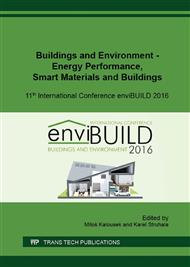p.190
p.198
p.206
p.213
p.221
p.231
p.239
p.247
p.255
Material of Thermal Insulation Affects Heat Gains in the Summer Period
Abstract:
Buildings with light-weight roof structures tend to suffer from overheating of attic spaces during the summer period. One of the methods for improving the indoor thermal comfort with no energy consumption is reducing the heat flux passing through the building envelope. In particular, this can be achieved by increasing the thermal inertia of the roof, specifically, by choosing materials with relatively high density and high specific heat capacity. This article focuses on evaluating of the roof assembly of an inclined insulated non-ventilated roof which meets the requirements for the passive house standard. A dynamic Comsol simulation with harmonic fluctuation of the exterior temperature was used to express the impact of the structure on the temperature damping and the time lag. The period of 7 days was screened. As a result temperature profiles of several material variants are compared.
Info:
Periodical:
Pages:
221-228
Citation:
Online since:
December 2016
Authors:
Keywords:
Price:
Сopyright:
© 2017 Trans Tech Publications Ltd. All Rights Reserved
Share:
Citation:


